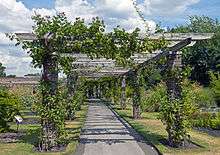Pergola

A pergola, arbor, or arbour is a garden feature forming a shaded walkway, passageway, or sitting area of vertical posts or pillars that usually support cross-beams and a sturdy open lattice, often upon which woody vines are trained. The origin of the word is the Late Latin pergula, referring to a projecting eave. As a type of gazebo, it may also be an extension of a building or serve as protection for an open terrace or a link between pavilions. They are different from green tunnels.
Description
Features and types
A pergola is a garden feature forming a shaded walkway, passageway, or sitting area of vertical posts or pillars that usually support cross-beams and a sturdy open lattice, often upon which woody vines are trained. As a type of gazebo, it may also be an extension of a building or serve as protection for an open terrace or a link between pavilions.
Pergolas may link pavilions or extend from a building's door to an open garden feature such as an isolated terrace or pool. Freestanding pergolas, those not attached to a home or other structure, provide a sitting area that allows for breeze and light sun, but offer protection from the harsh glare of direct sunlight. Pergolas also give climbing plants a structure on which to grow.[1]
Green tunnels
Pergolas are more permanent architectural features than the green tunnels of late medieval and early Renaissance gardens, which were often formed of springy withies—easily replaced shoots of willow or hazel—bound together at the heads to form a series of arches, then loosely woven with long slats on which climbers were grown, to make a passage that was both cool and shaded and moderately dry in a shower. At the Medici villa, La Petraia, inner and outer curving segments of such green walks, the forerunners of pergolas, give structure to the pattern, which can be viewed from the long terrace above it.
History
Origin


The origin of the word is the Late Latin pergula, referring to a projecting eave.[2] The English term was borrowed from Italian. It was mentioned in an Italian context in 1645 by John Evelyn at the cloister of Trinità dei Monti in Rome[3] He used the term in an English context in 1654 when, in the company of the fifth Earl of Pembroke, Evelyn watched the coursing of hares from a "pergola" built on the downs near Salisbury for that purpose.[4]
Historical gardens
The clearly artificial nature of the pergola made it fall from favor in the naturalistic gardening styles of the 18th and 19th centuries. Yet handsome pergolas on brick and stone pillars with powerful cross-beams were a feature of the gardens designed in the late 19th and early 20th centuries by Sir Edwin Lutyens and Gertrude Jekyll and epitomize their trademark of firm structure luxuriantly planted. A particularly extensive pergola features at the gardens of The Hill, Hampstead (London), designed by Thomas Mawson for his client W. H. Lever.
Modern pergolas
Modern pergola design materials including wood, vinyl, fiberglass, aluminum and CPVC (cellular PVC) rather than brick or stone pillars are more affordable and are increasing in popularity. Wooden pergolas are either made from a weather-resistant wood, such as western redcedar (Thuja plicata) or, formerly, of coast redwood (Sequoia sempervirens), are painted or stained, or use wood treated with preservatives for outdoor use. For a low maintenance alternative to wood, vinyl, fiberglass, aluminum and CPVC can be used. These materials do not require yearly paint or stain like a wooden pergola and their manufacture can make them even stronger and longer lasting than a wooden pergola.
See also
References
- ↑ "How To Build A Pergola" on Ron Hazelton's HouseCalls
- ↑ OED, s.v. "pergola;" Dictionary.com, "pergola".
- ↑ Diary and Correspondence of John Evelyn, F.R.S., 22 February 1645.
- ↑ Diary and Correspondence of John Evelyn, F.R.S, 20 July 1654.
External links
| Look up pergola in Wiktionary, the free dictionary. |
 Media related to Pergolas at Wikimedia Commons
Media related to Pergolas at Wikimedia Commons
| |||||||||||||||||||||||||||||||||
